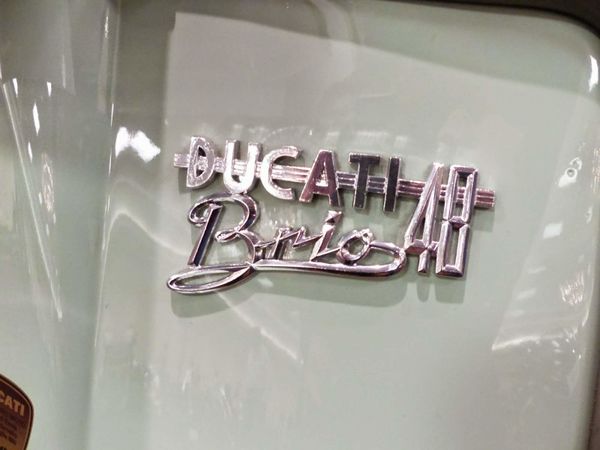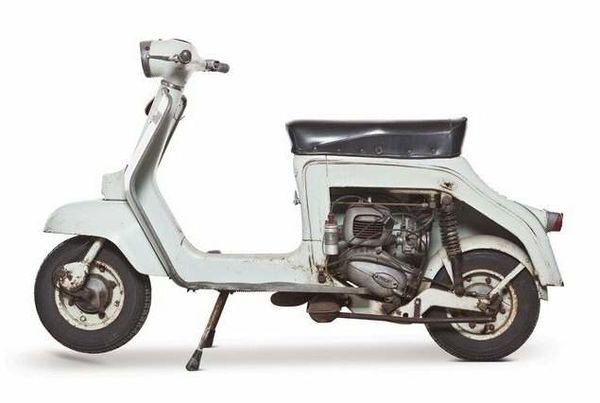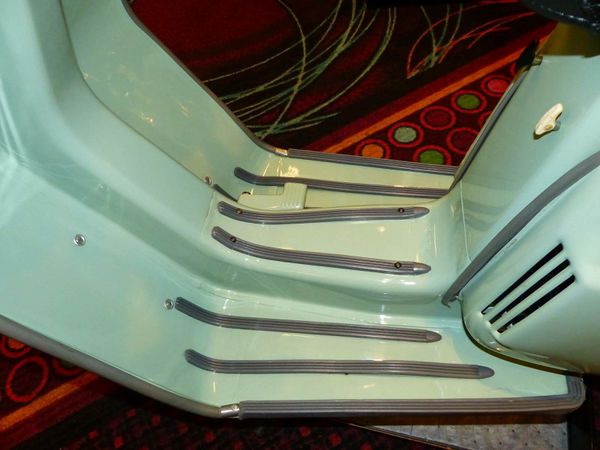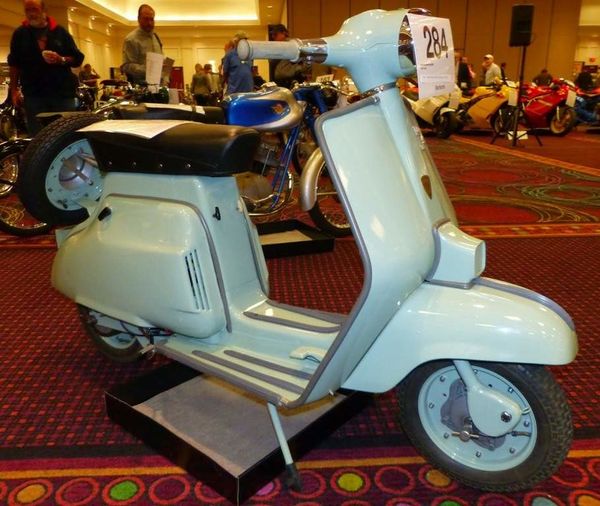Ducati 48/50 Brio
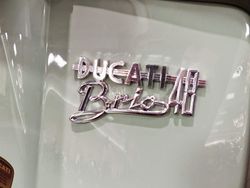 |
|
| Ducati 48/50 Brio | |
| Manufacturer | |
|---|---|
| Production | 1963 - 67 |
| Engine | Two-stroke, single cylinder, piston port |
| Compression ratio | 7.0:1 |
| Top Speed | 50 km/h / 31 mph |
| Ignition | 6V 18W flywheel magneto |
| Transmission | Three speed |
| Frame | Pressed steel |
| Suspension | Front: Swinging shackle fork Rear: Swingarm, dual rubber shocks |
| Brakes | Front: Drum, 105 mm Rear: Drum, 105 mm |
| Weight | 63.5 kg / 140 lbs (dry), |
| Manuals | Service Manual |
It could reach a top speed of 50 km/h / 31 mph.
Engine[edit | edit source]
The engine was a Fan cooled cooled Two-stroke, single cylinder, piston port. The engine featured a 7.0:1 compression ratio.
Drive[edit | edit source]
Power was moderated via the Wet, multiplate.
Chassis[edit | edit source]
Stopping was achieved via Drum, 105 mm in the front and a Drum, 105 mm in the rear. The front suspension was a Swinging shackle fork while the rear was equipped with a Swingarm, dual rubber shocks. The bike weighed just 63.5 kg / 140 lbs.
Photos[edit | edit source]
Overview[edit | edit source]
Ducati 48/50 Brio
These days, Ducati scooters arent what youd call the companys
bread-and-butter product. But there was a time when these little
rockets were pretty popular in the market, and one that stood out
was the Ducati Brio.
In an attempt to expand its market reach back in the 60s, Ducati decided to dive into budget two-strokes with the intention of creating as many variants of this line as possible.
One model that was born in this era was the Ducati Brio. First released in 1963 with the 48 Brio, the 100 Brio followed a year later in 1964. The latter enjoyed tremendous success in its time, thanks to its 100 cc single-cylinder two-stroke, fan-cooled engine that was mated to a three-speed transmission. Source:
The project for a second Ducati scooter came about with the aim of satisfying the demands of young people at the time. They wanted a versatile vehicle, which enabled them the opportunity to get around and go further without relying on public transport or their own two feet.
Bearing in mind the fact that many architects had provided designs for two-wheeled vehicles, the Ducati management invited the most important name at the time, Gio Ponti, to work on theirs. He thoroughly fulfilled the brief because the BRIO allowed many families to kick-start their everyday travelling plans.
Unveiled at the 1963 Milan Exhibition, the Brio was Ducati's second foray into the scooter market, around 10 years after the launch of the Cruiser 175. The 48 and 80 cc Motoscooter projects all date back to the period between 1957 and1962.
Ponti did not shy away from the concept of standard production, but identified its value in the perfection of his technical solutions. For the motoscooter, Ponti came up with evolutionary, innovative ideas (without forgetting practical requirements) and a stunning visual impact. He nodded to tradition and created models that people could recognise. He was an innovator who used new lines as the expression of new concepts and meanings.
It was a visionary yet highly functional object and all new, from the engine to the chassis, highlighting the company's commitment to a strategy of expanding its product range and introducing a series of two-wheeled vehicles with small, two stroke engines, which everybody could afford.
The main features of the scooter are: - forged sheet metal bodywork, with the front mudguard forming an integral part of the body; - the engine is located centrally on the swinging arm; a three-gear box has the changing control on the twist grip of the left handlebar; the two-stroke engine has fan-powered air cooling; the bore is 38 and the stroke 42, with a total engine size of 47.6 cc;- the primary drive uses gears while the final drive uses a chain, making it stand out from the competition. - the front suspension is based on a leading link system and the rear has a sheet metal swinging arm. The wheels are 1.75 x 9 and the tires are 23/4 x 9. - the central drum brake measures 105 x 20 mm. - the 6V - 18W flywheel-magnet-alternator provides electric power. - there are two bulbs in the headlamp: a 6V-18W one for the full beam and a festoon bulb, again 6V-18W for the low beam. The rear light uses a 6V-3W festoon bulb.
The Brio handled really well and covered 220 km with a full tank of fuel, at a regulation speed of 40 km/h.
One year after its launch, the Brio 48 was joined by a 100cc version, which was also used by the traffic police in Bologna, and was then replaced by the 50cc, with a 49.6cc engine and a more deluxe finish.
| Make Model | Ducati 48/50 Brio |
|---|---|
| Year | 1963 - 67 |
| Engine Type | Two-stroke, single cylinder, piston port |
| Displacement | 47.6 cc / 2.9 cu in |
| Bore X Stroke | 38 x 42 mm |
| Compression | 7.0:1 |
| Cooling System | Fan cooled |
| Induction | Dell'Orto SHA 14/12 |
| Ignition | 6V 18W flywheel magneto |
| Starting | Kick |
| Max Power | 1.1 kW / 1.5 hp @ 5200 rpm |
| Clutch | Wet, multiplate |
| Transmission | Three speed |
| Final Drive | Chain |
| Frame | Pressed steel |
| Front Suspension | Swinging shackle fork |
| Rear Suspension | Swingarm, dual rubber shocks |
| Front Brakes | Drum, 105 mm |
| Rear Brakes | Drum, 105 mm |
| Front Wheel | 2.75 x 9 |
| Rear Wheel | 2.75 x 9 |
| Dry Weight | 63.5 kg / 140 lbs |
| Top Speed | 50 km/h / 31 mph |
